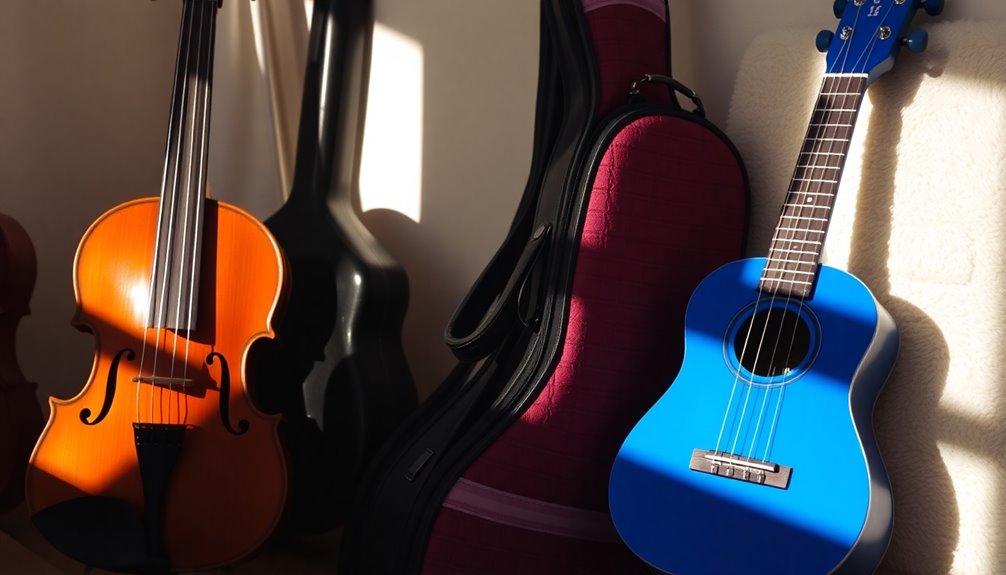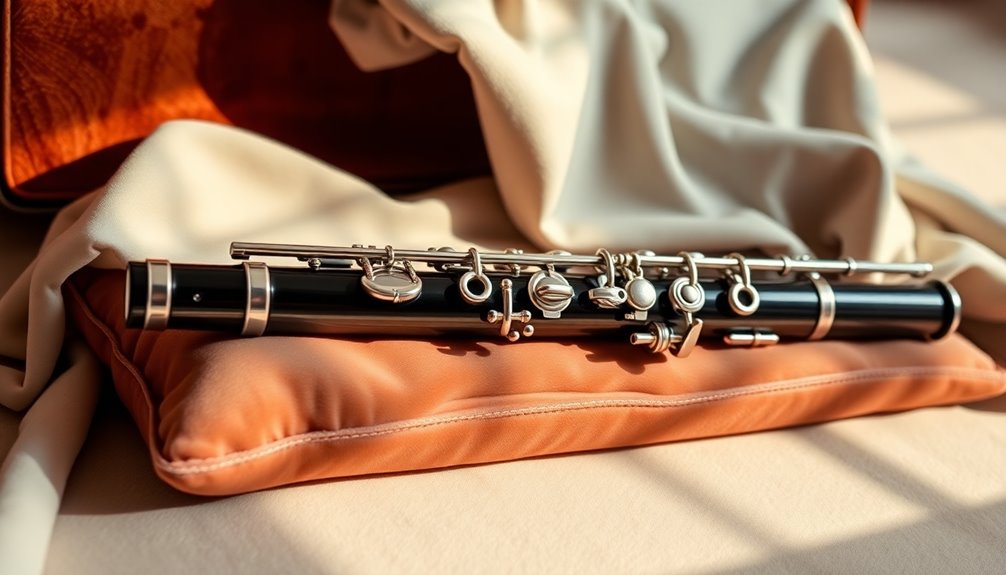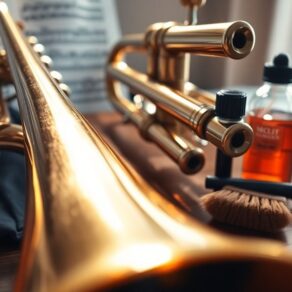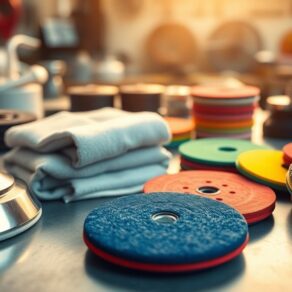To guarantee your instruments stay safe, start by choosing a hard-shell case for maximum protection. Maintain ideal humidity levels between 40%-60% with a hygrometer and consider using moisture packs. Clean your instrument regularly to prevent buildup and check for damage. Store instruments in a secure, dedicated location and keep them away from pets and moisture-prone areas. Avoid direct sunlight to prevent warping or fading. Finally, label your storage areas for easy access and organization. Master these tips and you'll safeguard your instruments effectively while inviting even more useful strategies into your routine.
Key Takeaways
- Choose a secure storage area, using lockable cabinets or drawers to deter unauthorized access and ensure peace of mind.
- Use quality hard cases or padded gig bags designed for your instrument to provide necessary protection against physical damage.
- Monitor humidity levels with a hygrometer and maintain an ideal range of 40%-60% to prevent moisture-related damage.
- Avoid storing instruments in moisture-prone areas, such as bathrooms or basements, to reduce the risk of long-term damage.
- Implement a consistent routine for returning instruments to designated spots after use, fostering care and ensuring they remain in safe storage.
Choose the Right Case

When it comes to protecting your instruments, choosing the right case is essential. A quality case doesn't just shield your gear from physical damage; it also reflects your commitment to your craft.
Start by considering the case materials. Hard-shell cases, often made from molded plastic or wood, provide superior protection against drops and impacts. If portability is a priority, look for lightweight options like soft gig bags, which are easier to carry but still offer decent protection.
Next, examine the case features. Look for cases with internal padding that keeps your instrument secure and prevents it from shifting during transport. Compartments for accessories like picks, tuners, or sheet music can be incredibly useful. Many stylish flute cases also come equipped with smart storage solutions that maximize organization.
Additionally, consider cases with weatherproofing if you'll be traveling in various conditions. A case with a sturdy handle and comfortable straps can make a world of difference when you're on the go.
Don't forget about lockable latches for added security, especially if you're leaving your instrument unattended. The right case should feel like a trusted companion, providing peace of mind and allowing you to focus on your music.
Maintain Humidity Levels

Choosing the right case is just the first step in safeguarding your instrument; maintaining proper humidity levels is equally important for its long-term health.
Fluctuations in humidity can damage wood, metal, and other materials, leading to costly repairs or even irreparable harm.
Here's how you can achieve effective humidity control for your instrument:
- Use a Hygrometer: Invest in a reliable hygrometer to monitor the humidity levels in your storage area. Ideally, you want to maintain levels between 40% and 60% relative humidity.
- Consider a Humidifier: If your environment is dry, use a humidifier to maintain moisture levels. This will help prevent excessive moisture absorption by your instrument, keeping it in prime condition.
- Add Moisture Packs: For cases that don't have built-in humidity control, consider using moisture-absorbing packs or humidity control packs. They can help maintain a balanced environment, preventing both excess and insufficient moisture.
- Store in a Stable Environment: Choose a storage location with minimal temperature fluctuations. Avoid areas near windows, heaters, or air conditioning units, as these can disrupt humidity levels. Regular maintenance of your instrument, such as using flute cleaning kits, can further enhance its durability and performance.
Clean Your Flute Regularly

How often do you clean your flute? If you're like many musicians, you might underestimate the significance of regular flute cleaning. Keeping your instrument in prime condition not only enhances its longevity but also improves your performance quality.
After each use, it's crucial to wipe down the exterior and swab the inside. This simple routine prevents moisture buildup that can lead to corrosion and sticky pads.
To start your cleaning process, gather some necessary cleaning tools. Invest in a good-quality cleaning rod and a soft, lint-free cloth. These tools are perfect for removing any residue or dirt that accumulates during play. You can also use a specially designed flute cleaner or a microfiber cloth to gently wipe the keys and body of your flute.
When swabbing the inside, gently insert the cleaning rod with a cloth attached, making sure to avoid any sharp edges. Don't rush this step; take your time to confirm you're reaching all the nooks and crannies.
If your flute has a more intricate design, consider using a small brush to clean around the tone holes and pads.
Regular flute cleaning not only maintains the instrument's appearance but also guarantees efficient airflow and sound production. By adopting this routine, you'll feel a sense of pride in your instrument and enjoy playing even more. Additionally, using a quality flute cleaning kit can provide the necessary tools for effective maintenance.
Plus, it's a great way to connect with your community of fellow musicians who also value proper instrument care.
Avoid Extreme Temperatures

To protect your flute's integrity, it's essential to avoid exposing it to extreme temperatures, as drastic changes can warp the materials and affect its performance.
Temperature fluctuations can lead to misalignments and even cracks, which can be devastating for any musician. By implementing some simple strategies, you can guarantee your flute remains in ideal condition.
- Store in a Climate-Controlled Environment: Always keep your flute in a room with stable temperatures. Avoid attics, basements, or garages where conditions can vary greatly.
- Use a Quality Case: Invest in a good-quality case that provides insulation against temperature changes. A hard case with a padded interior will help shield your instrument from external conditions.
- Avoid Direct Sunlight: Never leave your flute in a car or near windows where it can be exposed to direct sunlight. UV rays can't only heat the instrument but also cause permanent damage to its finish.
- Monitor Humidity Levels: While temperature is critical, humidity plays an important role too. Use a hygrometer to keep tabs on the moisture levels in your storage area. Aim for a relative humidity level of 40-60% for ideal preservation. Additionally, regular inspection for signs of damage can prevent issues before they worsen.
Store in a Safe Location

A secure environment for your flute is vital in preserving its quality and longevity. When choosing a storage location, consider both accessibility and protection. Ideally, you want a space that's not only safe but also convenient for regular use. A dedicated area within your home can serve as a fortress for your instrument, guaranteeing it remains unharmed by curious hands or unexpected accidents.
Implementing effective security measures is imperative. Lockable cabinets or drawers can deter unauthorized access, providing peace of mind when you're not around. If possible, choose a location that's away from high-traffic areas, reducing the risk of bumps or falls.
When it comes to storage containers, opt for hard cases or padded gig bags specifically designed for flutes. These containers offer added protection against drops, impacts, and environmental factors. Make sure the case is closed securely whenever you're not using it. Durable materials like ballistic nylon enhance the protection of your instrument from external elements.
Additionally, avoid storing your flute in places where it could be exposed to moisture, like bathrooms or basements, as this can lead to damage over time.
Lastly, remember that establishing a routine can enhance your flute's safety. Always return your instrument to its designated storage spot after use. By creating a habit of secure storage, you'll not only protect your flute but also foster a sense of belonging and care for your musical companion.
Your flute deserves a safe haven, so take the time to guarantee its environment reflects that commitment.
Use Flute Pillows or Cloths

Even with a secure storage location, incorporating flute pillows or cloths can significantly enhance your instrument's protection.
These simple additions provide an extra layer of safety, absorbing shocks and preventing scratches while guaranteeing that your flute remains in pristine condition.
Here's how to effectively use flute pillows and cloths for maximum protection:
- Choose the Right Material: Opt for soft, non-abrasive materials when selecting flute pillows. Microfiber or cotton cloths are excellent choices, as they're gentle on your instrument while effectively absorbing moisture.
- Wrap Your Flute Properly: When storing your flute, wrap it carefully with a flute pillow or cloth. Make sure that all key areas are covered, particularly the delicate keys and joints. This minimizes the risk of dents and scratches during storage.
- Use Cloth Storage Pouches: Consider using specialized cloth storage pouches. These not only provide cushioning but also help keep dust and dirt away from your instrument. Look for pouches designed specifically for flutes to guarantee a snug fit.
- Regular Maintenance: Make it a habit to check your flute pillows and cloths regularly for wear and tear. Replace them as needed to maintain their protective qualities. Additionally, maintaining regular key inspection ensures that your instrument's functionality is preserved while it's stored away.
Keep Away From Pets

Keeping your flute safe from pets is essential for maintaining its condition and longevity. Pets can be curious creatures, often drawn to shiny objects like your flute. To guarantee your instrument remains in pristine shape, you'll want to adopt effective pet proofing strategies.
Start by designating a specific area for your flute that's completely off-limits to your furry friends. Choose a storage space that's high up or locked away, such as a cabinet or a dedicated shelf, where pets can't reach.
You should also consider using pet-safe materials for your instrument case and storage options. Look for cases made from durable, non-toxic materials that can withstand the occasional bump or scratch.
In addition, make your home less enticing for your pets to explore. For example, if you're using a stand, guarantee it's in a low-traffic area and far from furniture that pets can jump on.
You might also want to invest in pet barriers or gates in rooms where you keep your flute. This way, you'll reduce the chances of an accidental knock or a playful paw.
Lastly, always remember to supervise your pets when they're near your musical space. It takes only a moment for a curious pet to cause damage. Additionally, consider using durable fabrics that balance flexibility and sturdiness to protect your instrument from unforeseen pet-related accidents.
Regularly Check for Damage

Making certain your flute remains undamaged goes beyond just keeping it away from pets; regular inspections are key to its upkeep.
A thorough damage assessment can save you from costly repairs or replacements down the line. By incorporating a consistent inspection routine into your practice, you'll cultivate a habit that helps you maintain your instrument's integrity and performance.
Here are four essential steps for effective damage assessment:
- Visual Inspection: Check for any visible cracks, dents, or corrosion on the body and keys. Pay special attention to the pads and corks for wear and tear.
- Functionality Test: Play your flute to make certain all keys are responding correctly. If they stick or don't close completely, it may indicate a problem that needs addressing.
- Moisture Check: Inspect the inside of the flute for moisture buildup. Use a cleaning rod with a cloth to wipe down the interior after each use, and keep an eye out for mold or mildew.
- Case Condition: Examine your flute's case for damage. A sturdy case protects your instrument, but if it's cracked or broken, it mightn't offer the protection your flute needs. Regular maintenance, including the use of a Deluxe Flute Care Kit, can significantly enhance the longevity of your instrument.
Avoid Direct Sunlight

Direct sunlight can be detrimental to your flute, as prolonged exposure can cause the material to warp or the pads to dry out. To guarantee your instrument remains in top condition, it's crucial to minimize sunlight exposure. UV rays can be particularly harmful, breaking down the adhesives and materials used in your flute's construction.
When storing your flute, choose a location away from windows or direct light sources. If you can't avoid placing it near natural light, consider using UV protection films or curtains to shield your instrument. Even a simple fabric cover can help protect it from the sun's harsh rays.
Additionally, think about investing in a sturdy, padded case designed for your flute. This not only provides physical protection but also serves as a barrier against sunlight. Some cases even come with UV-resistant materials that help keep your flute safe from harmful rays. Regular maintenance practices, including using a flute cleaning kit, will further ensure your instrument's longevity.
Remember that the environment around your instrument is just as important as the instrument itself. Maintaining a consistent temperature and humidity level can also play a role in protecting your flute from the damaging effects of sunlight exposure.
Label Your Storage Area

After taking steps to protect your flute from sunlight, it's time to reflect on how you organize your storage area. Effective storage organization not only keeps your instruments safe but also helps you quickly find what you need.
One of the best strategies to achieve this is by implementing a labeling system. Labels provide clarity and streamline your storage process, guaranteeing you can grab your instrument without hassle.
Here are four tips to help you create an efficient labeling system:
- Use Clear, Readable Labels: Opt for bold fonts and contrasting colors. This makes it easy to identify your instruments at a glance.
- Categorize Your Instruments: Group similar items together—woodwinds, brass, percussion. Label each category to simplify access.
- Include Maintenance Information: If an instrument requires specific care, add a note on the label. This helps you remember to take necessary precautions.
- Regularly Update Labels: As your collection grows or changes, keep your labels current. This guarantees your storage remains organized and efficient.
Additionally, incorporating a moisture control solution will help maintain the integrity of your instruments over time.
Frequently Asked Questions
How Often Should I Check My Instrument for Damage?
You should check your instrument for damage regularly to guarantee it's in top condition.
Ideally, inspect it before and after each use, looking for damage signs like cracks, dents, or loose parts. If you play frequently, consider doing a more thorough inspection monthly.
This routine helps you catch issues early, preventing further damage and maintaining your instrument's performance.
Consistent checks build your confidence and connection to your instrument, making each session more enjoyable.
What Materials Are Best for Cleaning My Flute?
When it comes to flute cleaning, you'll want to avoid using anything too harsh—like a medieval knight's armor cleaner!
Stick to gentle cleaning solutions, such as a mixture of warm water and mild soap. Microfiber cloths are great for wiping the body, and a soft brush can help clean inside the keys.
Make certain you dry it thoroughly to prevent moisture damage. Keeping your flute clean guarantees it always sounds its best!
Can I Store My Flute Upright or Sideways?
You can store your flute either upright or sideways, but it's essential to think about flute position for ideal protection.
If you choose upright storage, make certain it's in a padded case to prevent damage.
Sideways storage can also work, but avoid placing heavy objects on top.
Always opt for storage solutions that keep your flute secure and safe from dust or moisture.
Whichever method you prefer, just guarantee your flute stays well-protected!
Is It Safe to Store My Flute in the Car?
Storing your flute in the car isn't safe. Car temperatures can fluctuate drastically, leading to potential damage.
Extreme heat can warp the pads, while cold can cause moisture issues. To guarantee your flute's protection, always take it inside with you.
If you have to leave it in the car, consider using a temperature-controlled case, but it's best to avoid that situation altogether.
Keeping your instrument safe at all times shows how much you value it.
What Should I Do if My Flute Gets Wet?
If your flute gets wet, picture droplets glistening on its surface.
First, gently wipe it down with a soft cloth to absorb moisture.
Then, disassemble the parts and let them air dry in a cool, shaded area.
For flute maintenance, remember to store it in a case once it's dry to prevent moisture control issues.
Regularly check for any signs of corrosion, and your flute will stay in top shape, ready for your next performance.
Conclusion
To keep your instrument in top shape, remember that 60% of musicians report damage due to improper storage. By following these ten tips, you'll not only protect your investment but also enhance your playing experience. Choose the right case, maintain humidity levels, and regularly check for damage. Prioritize safe storage and regular maintenance to guarantee your instrument remains a source of joy for years to come. Don't wait for a mishap—start implementing these tips today!






